How do you actually sharpen a knife
Have you ever thought that you need to sharpen your knife but just don’t know where to start?
In this series from James Mandeville we’ll take you through the different stages of knife sharpening, this article continues with us getting stuck into sharpening techniques.
Sharpening a knife is all about technique. Once you have mastered the technique you can sharpen any knife. You need a sharp edge in a survival situation — it does not have to be perfect, just “sufficient onto the day.”
The poor survival knife is expected to fulfill many cutting and chopping functions and this is a lot to ask of one blade. Think about the number of knives you use in your kitchen at home in food preparation and eating. You may have to use your survival knife to chop through bone, de–scale and fillet fish, slice meat, cut down vines, slice fruit, cut Paracord, kill an animal, to name but a few uses.
Add cutting brushwood, splitting branches and hacking through vegetation and you get the picture.
So how can you use one poor knife to fulfill so many functions? The answer is in the edge you produce. A thin, sharp edge ground with a narrow-angle is useful for slicing and cutting but will not retain its sharpness (durability) for long if you whittle wood down with it.
A thicker, wider angle edge will perform chopping and whittling functions longer without the need for sharpening but is not very effective if you want to de–scale fish.
If you only have one knife, you have to learn how to regrind and sharpen it to give the edge you need for the job in hand. It makes good sense to carry two knives. Keep the drop point 15 cm (6 inch) blade for general rough work and a folding lock knife with a narrow angle and very fine edge for the more delicate jobs.
Use a wire saw to cut thicker branches and poles for shelter making. Do not use your precious knives for the wrong job because a lazy moment will cost you a lot of hard work recovering the blade edge later on.
Sharpening a survival knife (both folding knife and fixed blade drop point shape)
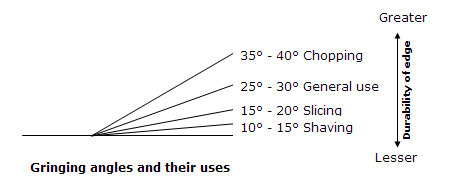
- The knife steel is not high quality and it will not take a sharp edge whatever you do.
- The blade design is too complicated, requiring several grinding angles.
- The grinding angle is incorrect for the chosen use of the knife. Keeping the grinding angle constant and the blade evenly in contact with the abrasive is not easy. A good angle to sharpen a survival knife is 25°, which as you can see from the above chart is a compromise. It will not fine slice a tomato or be very efficient at chopping wood but it will perform adequately all–round with good durability. If you have two knives, grind the fixed blade to 30 – 35° and the folding locking knife to 20 – 25°, use the fixed blade for cruder work and the folding knife for finer work.
- The burr has not been removed, leaving the blade rough.
- Blades that are hard coated (with titanium carbonitride) should only be sharpened on one edge. The hard coating on the non–honed side of the blade becomes the cutting edge. A frequent mistake is to sharpen both edges and this results in a less durable or dull knife edge.
On blades up to 10 – 15 cm (4 – 6 inches), use the thumb to set sharpening angle. A larger sharpening stone is preferable, but a smaller stone can be used.
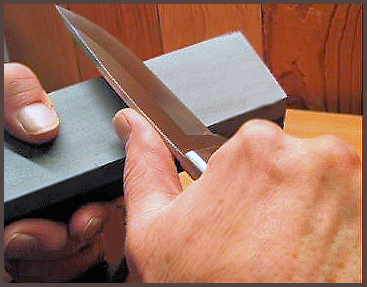
For larger blades, you can use both hands if more convenient: Use thumb and finger to set sharpening angle.
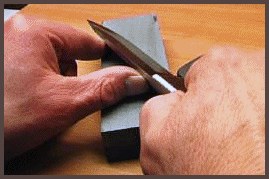
For smaller blades and a smaller stone, use the thumb.
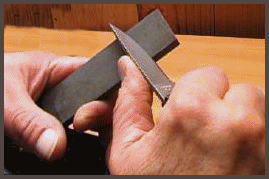
Method
Use a circular motion or push and pull the blade up and down the stone. Work the entire length of the blade; after several strokes, feel with your fingernail the edge of the side you are not sharpening to detect burr.
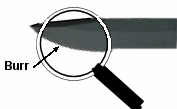
Once you have burr down the whole length of the blade, turn it over and sharpen the other side. Keep a constant pressure when grinding by resting the knife on your thumb (or thumb and finger for longer blades) and let your thumb rub over the abrasive.
Everyone has thumbs of different sizes, so find the place on your thumb and finger to rest the blade that gives the required angle. It can take over one hundred strokes to sharpen stainless steel and less for carbon steel. The metal of the cutting edge becomes very thin as it is being ground on the abrasive block and it will form a burr where the metal turns away from the abrasive.
Once you have burr, you are on your way to a sharp edge. You can feel the burr with your thumbnail. Never run your finger down the blade, only across it, for obvious reasons.
When you sharpen the other side of the blade the first few stokes will remove the burr. Once the second side forms a burr on the side you first sharpened, you have the edge. If your abrasive stone has both fine and coarse sides, give your blade a couple of light strokes over the finer abrasive to remove the burr.
If you have a Gerber Diamond Knife Sharpener, use this to remove the burr, a couple of light strokes are all that is needed. It is possible to polish the cutting edge further on a leather belt using a process known as “stropping,” but this is not necessary for a survival knife and somewhat impractical in the field.
Inspect the blade. If your angle is correct, both sides of the blade should be ground to the same angle. If one side looks as if more metal has been removed, then you have made the grinding angle shallower on this side and there is nothing for it but to start the process all over again. Test the edge by slicing it through paper; it should make a clean cut and not stick to the paper or tear it. If you do not have
Test the edge by slicing it through paper; it should make a clean cut and not stick to the paper or tear it. If you do not have paper in a survival situation, just use the knife for the intended purpose.
If it cuts the way you want it to cut, then you have a sharp knife. If it does not work as you intended, repeat the sharpening process making sure you sharpen the whole length of the blade by keeping the angle right and the pressure on the blade constant.
Sharpening serrated blades and gut hooks
Serrated blades retain their ability to cut effectively far longer than a straight edged blade, however, they are much more difficult to sharpen. It is necessary to use a tapered or cylindrical fine diamond steel or ceramic and each separate serration much be sharpened individually.
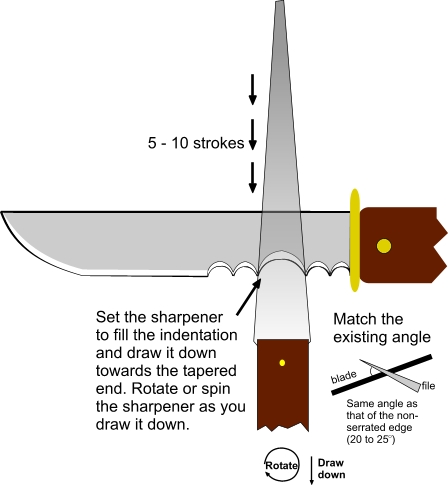
Serrated blades have a grind on one side of the blade, which is the only side you sharpen. Hold the sharpener at the angle that matches the original edge angle of the knife. It is best to clamp the blade down, or hold it with the edge away from you and the serrated side of the edge facing up. Set the tapered diamond sharpener in a serration so that you fill the indentation. It helps if you mark this position on the sharpener to stop you
Set the tapered diamond sharpener in a serration so that you fill the indentation. It helps if you mark this position on the sharpener to stop you honing too far down the taper and ruining the point on the serrated edge (see Gut Hook procedure below). Draw the sharpener towards the edge rotating or spinning it as you go; 5 –10 stokes of a fine grade hone should be sufficient. If the blade is very dull you may need to start with 5 –10
If the blade is very dull you may need to start with 5 –10 stokes of a medium grade hone, finishing with 5 – 10 stokes of a fine grade hone.
Even if you use a tapered sharpener it is almost impossible to achieve an edge that equals the original factory ground edge, but you can expect to get an edge that is good enough. A serrated blade is more easily distorted through sharpening than a straight blade edge. So, don’t sharpen it unless absolutely necessary. Most hardware shops and some of the better blade makers offer a sharpening service; if you are not confident you can sharpen a serrated knife, especially an expensive one, consider paying an expert to do it for you.
So, don’t sharpen it unless absolutely necessary. Most hardware shops and some of the better blade makers offer a sharpening service; if you are not confident you can sharpen a serrated knife, especially an expensive one, consider paying an expert to do it for you.
The main problem is getting the angle of the grind correct. A neat trick is to paint the serration with a black marker pen (Sharpie) so you can see if you are removing all the black ink. (If the blade is blackened already use a different colour marker.) This helps you to make small corrections to your angle of grind as you work. Check it after every stroke. Do not over–sharpen the serrations and do not use too much pressure. Always start off with a fine grade
Do not over–sharpen the serrations and do not use too much pressure. Always start off with a fine grade hone and only use a medium grade hone if absolutely necessary as it is easy to remove too much steel very quickly, ruining the cut of the serration.
Finishing off:
After you have honed all the serrations, feel the flat side of the blade with a finger nail. You should detect a very fine burr. If you cannot feel it, repeat the sharpening process with 5 more stokes of a fine hone on each serration until the burr is evident. Place the non-serrated side of the blade down flat on a fine diamond hone or fine whetstone and remove the burr with a couple of stokes using light pressure.
The right tools for the job
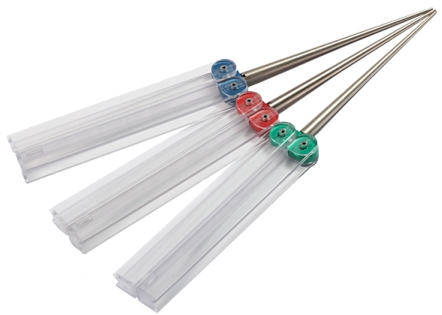

Lansy’s Folding Diamond Tapered Sharpening Rod (photo above) sharpens regular and serrated blades, fish hooks, gut hooks, and many other tools. The fine (600 grit) tapered rod folds into the ergonomic nylon impregnated plastic handle for protection and ease of carrying. Length when closed 8.9 cm (3.5 inches).
There are many such sharpeners on the market, for example, the Smith’s Pocket Pal illustrated below, but it comes only with one grade of diamond hone.
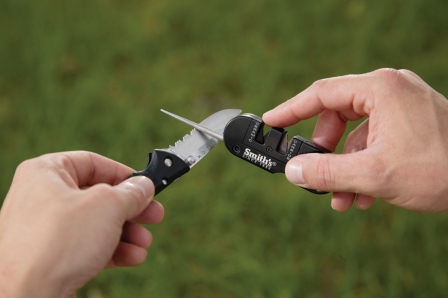
Sharpening gut hooks

This is a similar process sharpening a serrated blade, but a gut hook is honed on both sides of the blade. Use a ceramic or diamond tapered sharpener as for serrated knives. First, place the thicker end of the sharpener in the open end of the gut hook so it is not filling the entire width of the gut hook and wrap tape around the sharpener to help you not to
Use a ceramic or diamond tapered sharpener as for serrated knives. First, place the thicker end of the sharpener in the open end of the gut hook so it is not filling the entire width of the gut hook and wrap tape around the sharpener to help you not to hone past this position. If you hone filling the entire width of the gut hook with the wide end of the sharpener, it will enlarge the gut hook curve and distort the cutting edge.
Unlike sharpening a serrated knife you do not start with the wide end of the sharpener in the gut hook, position the pointed, narrow end of the sharpener up against the open end of the gut hook.
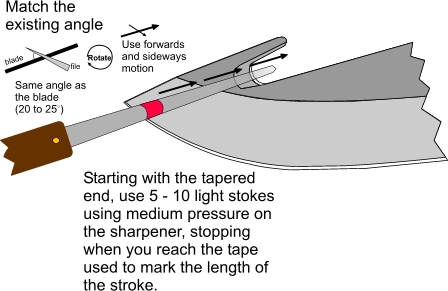
Make sure the sharpener is facing toward the thickness of the blade (away from the edge of the gut hook). Match the angle of the sharpener to the original edge angle of the knife. This will maintain the correct sharpening angle and prevent you from getting cut by the blade tip. Use 5 – 10 light stokes using medium pressure on the sharpener, stopping when you reach the tape used to mark the length of the stroke. Using a forward and sideways motion, stroke the sharpener from one side of the gut hook to the other. Spin the sharpener as you go. As with sharpening a blade edge, the objective is to start at the edge and stroke away from the edge. Do not over-sharpen or put too much pressure on the sharpening tool.
Using a forward and sideways motion, stroke the sharpener from one side of the gut hook to the other. Spin the sharpener as you go. As with sharpening a blade edge, the objective is to start at the edge and stroke away from the edge. Do not over-sharpen or put too much pressure on the sharpening tool.
Hone alternate sides and check your progress often. As with other blades, you can mark the cutting edge of the hook with a permanent marker pen (Sharpie) to help you get the angle right. Examine the hook after each stroke to make sure you are removing all the ink and not going beyond the ink mark.

He has many years experience in difficult terrain, notably the Amazon, the African bush and climbing in various mountain regions including the Drakensburg Mountains and the Andes.
If you have any comments then please drop us a message on our Outdoor Revival facebook page
If you see a good product or have a blog you would like to share let us know about it on our FB page, we’re also happy for article and review submissions , we’d love to hear from you.
Outdoor Revival – Reconnecting you to the outdoors





